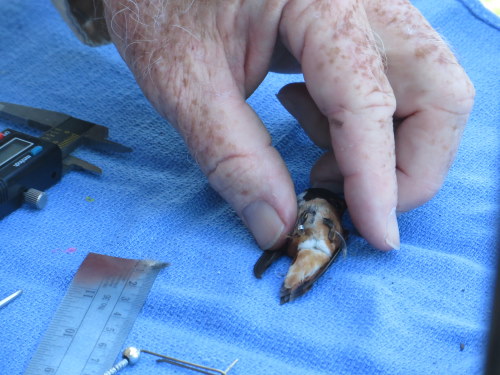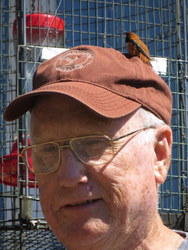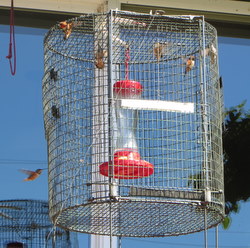
Master bander Fred Bassett says captured hummingbirds are “tough as nails and mean as snakes.” (Kitty LaBounty photo)
Hummingbirds made their way back to Sitka on schedule this spring. But this year, for the first time, they’ve also been followed by a hummingbird bander.
Fred Bassett is a “master bander” from Alabama who spent three days in Sitka last week capturing and banding 153 hummingbirds, most out at Medvejie hatchery Silver Bay.
Bassett has been studying hummingbirds for 20 years. He has an individual permit from the federal government to capture the birds. And his work is already changing our understanding of Alaska’s most common species, the rufous hummingbird.
The rufous is one of a number of so-called “western” hummingbirds who are thought to winter exclusively in the western half of north America.
Bassett, however, has banded many rufous in his home state of Alabama and in Florida — over 2,000 in the past two decades. He told KCAW’s Matt Goff, host of the Sitka Nature show, that he doesn’t think western hummers made the move back east recently.
As far as I’m concerned, they’ve been doing it for a long, long time. People didn’t know about it because up until people like me came along and started doing winter banding, everyone was told they had to take down their feeders by a certain date. They were good soldiers and took down their feeders. And then if they did happen to see a hummingbird and reported it to Fish & Game or Audubon they were told, I know you thought you saw a hummingbird but there’s no hummingbirds here in the winter. That was a moth. I came along and started giving talks about leaving feeders out. Not only do I believe you have a hummingbird at your house, I’ll come along and catch it. Amazingly enough, western hummingbirds started to show up.
Although doing basic research in Alaska is gratifying, Bassett wouldn’t mind recapturing one of the birds he’s already banded in Florida.
The real reason I’m here is that the world record for a banding and a recapture was a rufous three years ago that one of my sub-banders in Tallahassee, Florida, captured in a yard in January. In June that bird was recaptured in Chenega Bay, which is an island off of Valdez. That’s 3,600 miles away. And the last two winters down on Alabama’s Gulf coast I’ve caught the same female rufous, and that bird was banded in NW British Columbia. They don’t nest there. That bird was coming out of Alaska, cutting across, heading into the Southeast. I was giving a talk just like this on public radio telling a lady that they’re coming out of Alaska but they’re not getting caught on the end, because there are no hummingbird banders. And she said, Why don’t you go up and find out? Here I am!
Listen to iFriendly (iAngry?) audio.
In fact, he says a captured hummers can be “tough as nails and mean as snakes.”
On this trip Bassett has banded hummingbirds in Ketchikan and Juneau. He’s currently in Haines, with plans to band birds later this summer along the Southcentral coast of Alaska.

































